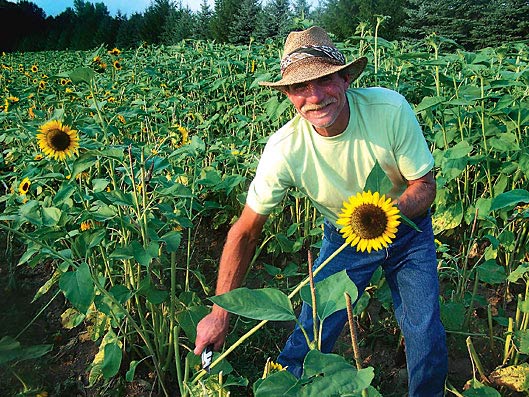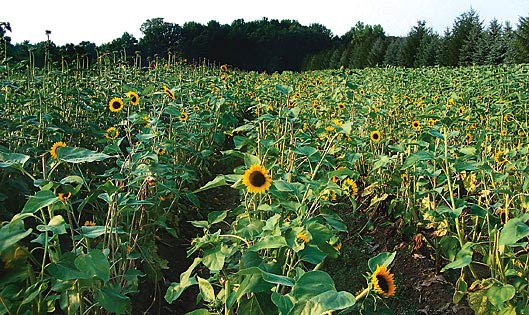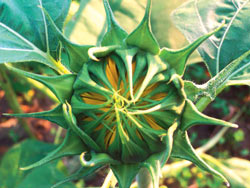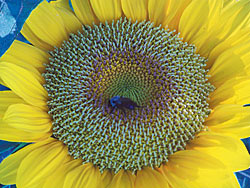Bob Koenders shares pointers on how to best grow this popular flower
 Photos by Sandie Parrott
Photos by Sandie Parrott
Bob Koenders demonstrates how to cut sunflowers: strip the lower leaves and cut diagonally with a sharp, clean boxcutter, and place immediately in water with preservative.by Sandie Parrott
Why sunflowers
When Koenders married the love of his life, Judy, they used lots of happy sunflowers for their wedding. In fact, sunflowers and even sunflower bouquets for the bride are becoming more popular for weddings according to Koenders. Florists in the area didn’t even know they wanted sunflowers when Koenders started experimenting with varieties. “I grew about 50 different varieties until I found about 5 that I grow every year.” They are all the pollenless varieties. “Now the demand is so high, the florists are calling me!” he exclaims.
 At dusk, a field of sunflowers begin to turn their heads toward the setting sun. Notice the hilled rows of soil that help support the heavy plants.A little bit of history
At dusk, a field of sunflowers begin to turn their heads toward the setting sun. Notice the hilled rows of soil that help support the heavy plants.A little bit of history
According to the National Sunflower Association, the wild sunflower is native to North America, but commercialization of the plant was done by Russia. It was only somewhat recently that the sunflower plant “returned” to America. Native Americans first developed the wild sunflower into a single-headed plant with a variety of seed colors including black, red, white, and striped black and white. Some archeologists suggest that sunflowers may have been domesticated before corn. The Native Americans used the sunflower seed for grinding into flour, trail snacks, purple dyes, body painting, ceremonial, and medicinal uses. Sunflower oil was used for making bread, as well as on skin and hair. The dried stalks were even used for building materials.
The large Russian varieties are still available today. Names like ‘Mammoth Russian,’ ‘Russian Giant,’ ‘Tall Russian,’ and ‘Mammoth’ are all typical varieties sold as giant sunflowers, along with all the new American, European and Asian hybrids. Koenders says identifying sunflowers can be a problem—there are always several names for essentially the same plant. He advises purchasing seed from reputable sources if you want a plant that grows true to the variety.
 This unopened bud of ‘Sunrich Gold’ is still too early to cut but still beautiful and pollenless like most of Koenders’ sunflowers.Cutting sunflowers
This unopened bud of ‘Sunrich Gold’ is still too early to cut but still beautiful and pollenless like most of Koenders’ sunflowers.Cutting sunflowers
Giant sunflowers wouldn’t work well as cut flowers, according to Koenders. They would be difficult to sell, handle (you practically need a chain saw to cut them) and use in a vase (the stalks are too thick and long). Koenders’ goals for the ideal cut sunflower: no pollen, 1/2-inch thick stem of about 3 feet in length, straight with a perfect flower head (held high) about 3 to 5 inches across. A “perfect” flower means no disfiguration, consistent color, and no diseases or pests.
During cutting, most of the leaves are stripped in one quick motion, leaving only the large ones by the head, and then a sharp box cutter is used to swiftly and cleanly cut the stem at an angle by the plant’s base. Cut flowers go directly into a solution of preservative and bleach until he delivers them, usually within 24 hours. Koenders and his hardy workers cut 7 days a week, 1,000 to 1,500 stems a day, which is just under 100,000 flowers annually.
 This ‘Sunrich Gold’ sunflower is open too far to be cut for the floral industry. It will be sold directly at a farmers’ market or roadside stand.Growing sunflowers for cutting
This ‘Sunrich Gold’ sunflower is open too far to be cut for the floral industry. It will be sold directly at a farmers’ market or roadside stand.Growing sunflowers for cutting
The process begins with purchasing F1 (first generation) pollenless seed of proven varieties from quality sources. “It is more costly, but the plants are far superior. Saving seed means genetic variance, which can be good or bad,” Koenders comments. “Reusing seed means colors and sizes vary from plant to plant and stems can be weak, since it is open-pollinated (uncontrolled pollination by wind, insects, or birds). For homeowners, give it a try—it is fun to see what you get, but I can’t afford the risk.”
The other big component is good soil, and his farm has wonderful lake bed loam. Koenders monitors his soil, testing it every one to three years, depending on diseases or pests during that time, not just because he is an agronomist, but to check the levels of nitrogen and other nutrients. “Nitrogen is important for sunflowers. Nitrogen leaches out, but too much makes them leggy with large leaves.”
Seeds are started April 1 in the greenhouse. Sunflowers germinate in cool temperatures (45 to 50 degrees), and starting in early May seedlings are planted in the field. Seeds are started and plants are moved to the field every 7 to 10 days for about 10 successive plantings. “We can’t have them all in bloom at once, since we can’t harvest and sell all at once,” says Koenders. A tip he shares is to mound up the soil around the base of the plant to help support the stem. He continues to mound the soil while they are growing to help support the plant and to bury weeds. The mounded earth can get as high as a foot by the time the flowers are cut. He cautions, however, to not cover any leaves.
Plants are set close together (6 to 12 inches) for support and to keep the plant size manageable, but he recommends up to two feet in a backyard situation for larger flowers. Rows are about 3 feet apart for cultivation. Pruning is important for florist quality blooms. Koenders prunes excessively to produce the type of perfect flower you expect to see at the florist.
“Sunflowers have a bad reputation with some people. Although they are pretty, many people think they don’t last, heads droop, and the stems are too thick,” Koenders laments. “This is because some sunflowers are dry-shipped from long distances like South America with their foliage stripped off.” According to Koenders, local pollenless sunflowers should have thinner stems and heads held high, and last 7 to 10 days in a vase (out of direct sunlight).
So the next time you want to brighten one of your late summer or fall days, pick up some cut sunflowers. You now know what qualities to be looking for.
Sandie Parrott is a garden writer and photographer who lives and gardens in Oakland County, MI.
•••••••••••••••••••••••••••••••••••••••••••••••••••••••••••••••••••••••••••••••••••••••••••••••••••••••••••••••••••••••••••••••••••••••••••••••••••••••••••••••••••••••••••••••••••••••••••••••••
Fun facts about sunflowers
- Sunflower’s scientific name is Helianthus; Helios meaning “sun” and anthos meaning “flower.”
- Sunflower heads track the sun’s movement; this phenomenon is called heliotropism.
- Sunflowers can grow up to 12 inches a day during the peak of the growing season. They are more photosynthetic than many other plants and better utilize the sun for growth.
- Sunflowers (certain varieties) yield up to 40 percent of their weight in oil.
- Sunflower stems were used as filling for life jackets.
- Sunflowers are considered a popular art form because of their “human-like” characteristics, such as the “head” and the similar height to humans.
- Sunflower leaves are cupped to channel the water down the stem.
- Sunflowers were worshipped by the Aztecs.
- Sunflower heads consist of 1,000 to 2,000 individual flowers joined by a receptacle base. The large petals around the edge of the sunflower head are individual ray flowers which do not develop into seed.
- The world record tallest sunflower (25 feet, 5-1/2 inches) was grown in the Netherlands in 1986.
- The world record sunflower with the largest head (32-1/4 inches in diameter) was grown in Canada in 1983.
- The world record sunflower with the most heads (837) was grown in Michigan in 2001.
•••••••••••••••••••••••••••••••••••••••••••••••••••••••••••••••••••••••••••••••••••••••••••••••••••••••••••••••••••••••••••••••••••••••••••••••••••••••••••••••••••••••••••••••••••••••••••••••••
How to grow sunflowers – Tips from Bob Koenders
Light – All day sun.
Soil type – Not particular about type, but must have good drainage. Ideal pH range is 6.5 to 7.5.
Moisture – Water to start seeds and seedlings; water older plants during dry spells; they are drought tolerant, but will wilt when they need water.
Seed depth – Approximately 1/4 to 1 inch deep; very easy to germinate and grow.
Soil temperature for germination – 45 to 50 degrees.
Sowing – Sow seeds in successive plantings for cut flowers throughout the summer and fall.
Spacing – 6-12 inches for smaller varieties and up to 24 inches for larger varieties; allow at least 3 feet between rows for cultivation and air circulation.
Staking – May be required, unless grown closer together or up against a fence. Mound soil around base to support plant.
Fertilizing – Watch the salts. Sunflowers are very salt sensitive.
Pinching – Useful for forcing side shoots or pushing all the energy into one head.
Cutting – Plants should be cut when the bud is just beginning to open and is showing a little of the petal color. Strip off most of the lower leaves but leave larger ones by the head. Cut at an angle with a sharp and clean tool. Put in water with preservative immediately.
Height – Ranges from dwarf plants of 1-2 feet to giants of 15 feet or more.
Colors – Available colors range from white and cream, to all shades of yellow through to orange, red and burgundy. Centers can be yellow, green, brown, black, and black and white.
Recommended varieties – Gold-orange: ‘Soraya,’ ‘Sunrich,’ ‘Pro-Cut’ and ‘Sonja.’ Burgundy: ‘Moulin Rouge’ and ‘Prado Red.’
•••••••••••••••••••••••••••••••••••••••••••••••••••••••••••••••••••••••••••••••••••••••••••••••••••••••••••••••••••••••••••••••••••••••••••••••••••••••••••••••••••••••••••••••••••••••••••••••••

Darcy Ellinger says
My daughter LOVES sunflowers. We’re getting ready to start taking her graduation pictures. I’d love to have some of her pictures taken surrounded by sunflowers. We’re in Jackson County. Is there anyplace in Jackson, Barry or Kalamazoo County where this would be possible?
We’d really appreciate any suggestions you might have.
jhofley says
Darcy-
Unfortunately, I don’t know of any in your area. We did a feature on Backyard Bouquet Farm in Armada which you can check out here:
http://www.michigangardener.com/sunny-sunflowers-bring-happiness/
Another idea would be to contact your county extension to see if they have suggestions. You can find a list here:
http://www.msue.msu.edu/portal/default.cfm?pageset_id=25744&page_id=25770&ms%20ue_portal_id=25643
Thanks for reading!
-Jonathon
george says
My name is george. Hoping to grow sunflowers for my wedding end of may. When should I plant and would it be better to use containers rather than cut them? Transportation wise it seems easier to cut but i need them to last the wedding.
jhofley says
George-Thanks for reading. That sounds like a tight window to grow sunflowers from seed but I would go to your local independent garden center and ask their advice as there are many sunflower varieties to choose from, each with different germination times. Thanks for reading! -Jonathon
Mg says
Would growing sunflowers for a late June wedding also be too small of a window?
jhofley says
If growing from seed, yes that would be too short a window. If you were to plant seed now, you the soonest you would see blooms would be mid-summer. Thanks for reading Michigan Gardener!
Brittaney Keller says
Do you have place that people can get married, I’m looking to have my dream wedding and it has always s been to get married by a sunflower field?
jhofley says
Two thoughts come to mind. First, try and contact Bob Koenders from Backyard Bouquet Farm in Armada, MI. Next, I beleive Ford Motor Co. still plants acres of sunflowers each year around their headquarters in Dearborn. Best of luck with your weddding and thanks for reading! -Jonathon
patti says
We live in the u. p. of michigan and have a wedding on labor day. we are using sunflowers and would like to know if you sell them or know of anyone in the u.p. that does thanks
jhofley says
Patti-
Unfortunately we do not but maybe try and check with your local extension office. Here is a list:
http://msue.anr.msu.edu/county
Thanks for reading!
-Jonathon
Gary Shermetaro says
The City of Oak Park is working on a Sunflower Project for 2016. We want to keep it simple and plant only yellow sunflowers in various locations throughout the City. We are starting the plants from seed and are getting help from local schools with the initial seed planting process. The schools will keep the seeds in small planter pots on window sills until the time is right to transplant them outside. Does anyone have a recommendation for the best place to purchase a 3,000 high quality yellow sunflower seeds?
Thank You,
Gary Shermetaro
City of Oak Park DPW
248.867.2828 cell
jhofley says
Gary, thanks for reading. You might check with Dale at Uncle Luke’s Feed Store in Troy.
Carol Branson says
Have planted several succession plantings of pro cut orange sunflowers for a wedding. They are needed the middle of August. First planting was the first of June and every 3-4 days after to the 13th of June. Was wondering how many days once they have flowered do the flowers last on the plant. I don’t want to cut them to soon before the wedding. Thank you.
jhofley says
Carol-
A variety of factors would likely impact that including rains, drought, wind, etc. Check with your local garden center or extension service. Best of luck with the wedding!
http://msue.anr.msu.edu/county
-Jonathon
Victoria Miesle says
Whatever you do, please get permission from the landowner. 🙂
Karolynn Schofield says
I live in Saline, Michigan. We just took 2 acres and went through the prescribed burn and will be planting native grasses, but I asked them to leave me 10′ deep of the yard so I can plant sunflower seeds. Most of mine come up by itself from the previous year so the question I have is do I spread the seeds this fall and let them winter and see if they come up or is it best to sow seeds in early spring? Lastly, is it safe to use the seeds I purchase in large pounds to feed the birds? If not, can you help where I can get large quantities of seeds to purchase.
jhofley says
Karolynn – Sorry for the delay. Check with your local independent garden center for the seeds and advice on planting. The places to grow feature in Michigan Gardener is a helpful tool to locate garden centers in your area. You can view it in our digital editions. Check page 4 of each issue to locate where it appears in each issue. Thanks for reading! -Jonathon